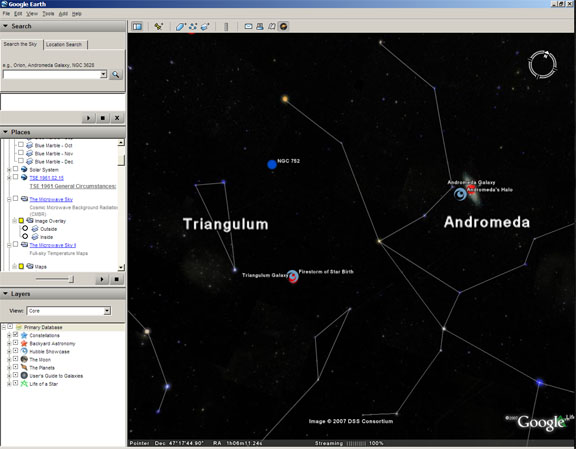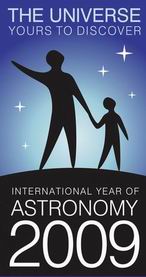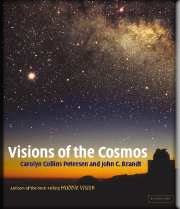 |
 The SpaceWriter's Ramblings |
 |
||
|
|
|
|
||
|
Anything and everything about science, especially astronomy and the cosmos. NOTE: This blog has migrated to a new address. Please update your favorites link accordingly.Visit my web site at Posting times are Powered by
|
8.22.2007 Googling the Cosmos A view of the universe from Google EarthJust when you thought Google had covered just about everything here on Earth, they've come out with a cosmic exploration tool accessible through Google Earth. To get it you have to download and install the latest version of Google Earth 4.2 (available for PC, Mac, or Linux). Laid out before you are stars, nebulae, and galaxies (including some of the most distant ones ever seen), all accessible through the same navigational tools as regular Google Earth. You also get constellations and a whole Backyard Astronomy layer, complete with images as seen by naked eye and telescopes. Hubble Space Telescope imagery, and two informative layers about the life of a star and the users guide to galaxies complete the opening set. I can imagine that once people get hold of this and play with it for a bit that there will be a blossoming of .kmz files (the overlays) out there for all kinds of tours and educational trips through the cosmos. This is one of those times in the development of the internet and the World wide Web when I look back over how far we've come. The first computer I ever used was a mainframe that our high school had access to from a local research establishment. We programmed it in BASIC, although the advanced types could do FORTRAN or COBOL. The output? Paper printouts. The first computer I ever owned was an Osborne Executive that Mark and I bought in the early 1980s. My first modem followed shortly thereafter. The output? Paper printouts. On the screen it was all ASCII. In record time we went from that tiny 128K machine to Kaypros and Dells, each one bringing us more and more capability for office apps, plus access to content on what was becoming the Internet. Today, almost a quarter century later, we're reaching out to the cosmos with Google and other accessible tools. The other night I was watching movies on my computer and had to stop and marvel for a second about how commonplace it all is now. But, 25 years ago, not so much. If anybody had told me then that I'd be accessing images from an orbiting space telescope, using my computer and a network to send my work to clients around the world, and exploring the distant cosmos with a program that made it as easy as a mouse click—well, I wouldn't have believed them. For those of you who have grown up with the wonders of the Web and Internet at your fingertips, it's all as new as today. I think it's great and now I'm going to stop reminding myself about the distant past. The future's here folks. Enjoy! Now, go download the new Google Earth and get to work exploring! Labels: astronomy, computers, Google Earth, Google Sky posted by CCP on 8/22/2007 02:21:00 PM | * |

Earth Hour! Do it for the Planet!
Blog RollPlanetarium-relatedLoch Ness ProductionsPurveyors of fine planetarium shows, music, and services. INTENSELY Good Space Music from a master in the genre! My cool astronomy cause: ScienceThe sites below belong to space and astronomy enthusiasts. I make every effort to check them and make sure they are still appropriate. However, I am not responsible for their content, nor do I endorse any of it by simply linking to them. As with all Web surfing, please exercise caution. Adot's Notblog A fellow traveler blogger and astronomy enthusiast! Astronomy Blog An astronomy blog pondering the big questions Astronomy Cast Astronomy Podcasting from Pamela Gay BadAstronomy.com Bad astronomy discussed and debunked along with fun stuff about really good astronomy! Chris Lintott's Universe Musings from an Oxford Astronomer. Cosmic Variance Random Samplings from a Universe of Ideas. Dave P's Astronomy blog Observational Astronomy and other TidBits European Southern Observatory Fine Ground-based astronomy images. Gemini Observatory Fine astronomy in infrared and visible wavelengths. Griffith Observatory's page. I wrote their exhibits! Observing The Sky Nightly Observation Reports from dedicated skygazers. The Official String Theory Web Site. Time to feed your mind! Pharyngula Evolution, development, and random biological ejaculations from a godless liberal. Cast off your blinders and come on in! Science Made Cool A compendium of discoveries, inventions and commentary. Slacker Astronomy Astronomy with a Slacker Twist. Space Telescope Science Institute The best from Hubble Space Telescope The Eternal Golden Braid Astronomy, Space Science, and Science Fiction Commentary. The Inoculated Mind Bills Itself as a weekly science mindcast. Thought-provoking, honest. Truth. UniqueThe Hairy Museum of Natural History
|




